The toy industry sells us the story that our children need toys to be happy. In fact, we are sold the story that our kids need lots of new toys to be content. You may have come to believe that more toys=more joy and find yourself spending countless dollars attempting to prove this theory to be true. You aren’t alone, in 2020 the toy industry brought in over $95 million in global sales.
These numbers surely bring a lot of happiness to the toy industry. But what about our kids?
Let me tell you our story. When I became a new mother, I was ready to give my baby everything. All the toys, all the love, all the best.
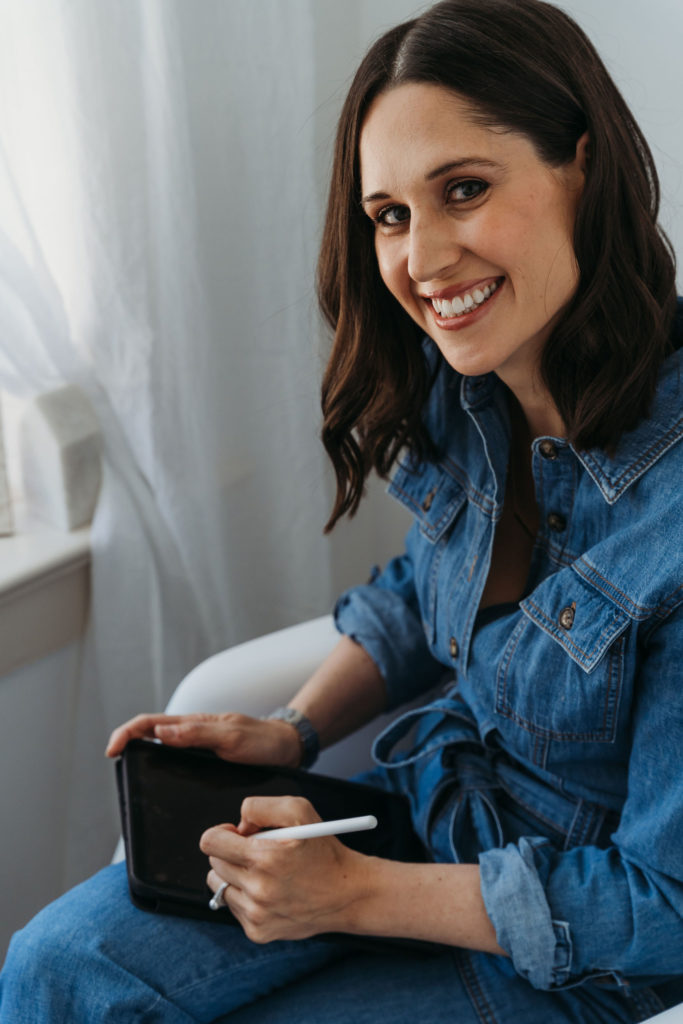
This motto “more is better” wasn’t new to me. I entered motherhood with a lifelong history of clutter–both physical clutter and mental clutter. But I had different circumstances than most when I gave birth to my first child. At that time, I was finishing up my doctorate in Child Development.
That means, during my first pregnancy, I was elbow deep in more than just clutter—I was also immersed in the research about what children really need to grow, learn, and thrive.
Much to my surprise, there was nothing in the research that supported the idea that buying lots of toys was actually good for our kids. In fact, having fewer toys benefits our kids in more ways than you can imagine. Over the past decade, I’ve turned thousands of families into believers of the benefits of fewer toys.
And I can tell you one thing for sure, you will never look back.
Not only does fewer toys benefit the development of the child, but also the well-being of the parents. Because the way we buy for our children teaches them. That’s why I want to share with you 9 things that kid’s learn by having fewer toys.
WANT THE LIST OF THE 15 BEST SIMPLE TOYS?
You can also listen to this here:
Podcast: Play in new window | Download | Embed
9 Things That Kid’s Learn by Having Fewer Toys
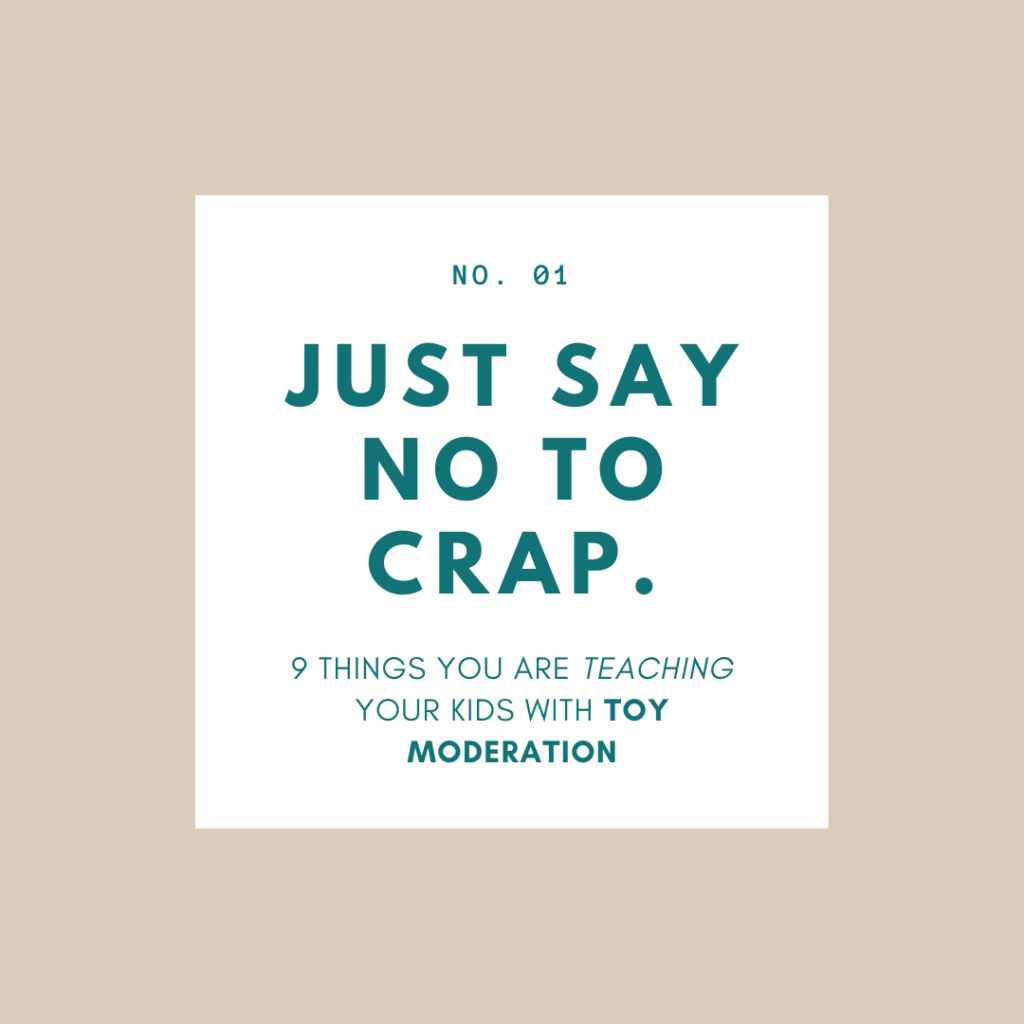
1. Just Say No to Crap
When we tell our children “no” to new toys and we limit the number of trinkets that they acquire—we are not being mean. We are teaching. We are teaching our children that what comes into our house must eventually leave our house. And did you know that most plastic toys end up in the landfill for up to 500 years? That life-size plastic Sven Reindeer and Barbie Dream House [sorry Barbie, I’m going there…] are going to outlive your grandchildren’s great-great-great grandchildren.
So let’s say no to plastic crap. Let’s say no to the stuff that’s going to lose their interest quickly. Let’s say no to the flashy stuff the marketers dump billions into selling to our kids. Because when we say no to junk, we are sending our kids a message. The way we buy MATTERS. We have a choice. We have an impact on the world that is greater than we know.
PS-if you already have the Sven and/or the Barbie Dream House, no shame. Just make sure it finds a good home after it leaves your house and starting today: Say no to crap. If you are a new believer in the benefits of fewer toys for kids, give yourself some grace.
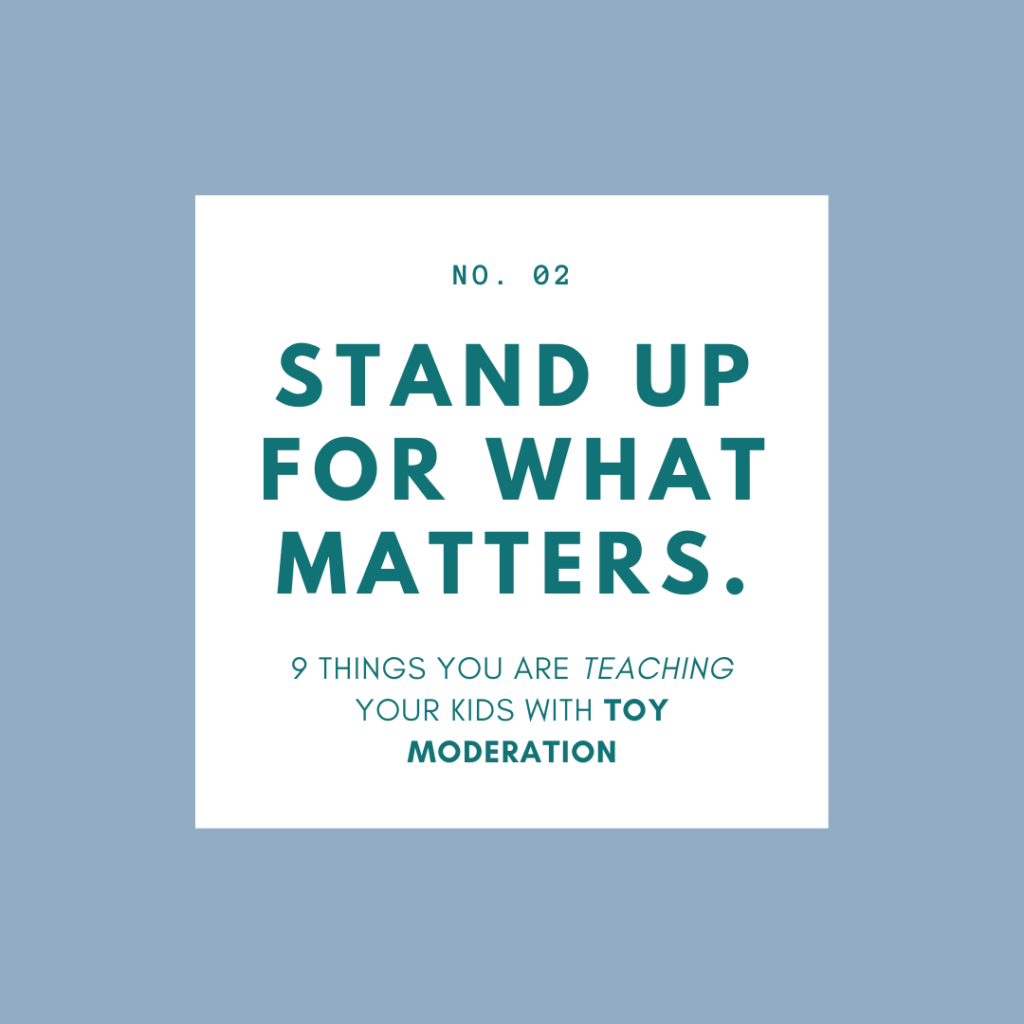
2. Stand Up For What Matters
I know what you are thinking—“I don’t buy all these toys, it’s the GRANDPARENTS!” I hear this all.the.time. I get it. It’s super awkward to have the conversation with your family members about buying less for your kids. You don’t want to sound unappreciative and/or ungrateful.
Instead, maybe you just take the “Smile, say thank you, and donate later approach.” But to me, that never feels right either. There is guilt that sticks around. Who wants to live in fear of being “found out”?
I’m here to say, we must be brave. We need to talk to our family members. We need to tell them that simplicity is a core family value that we are teaching our kids and we need their help. As parents, we have to stand up for the family values we are instilling in our children. Because one day…the time will come that our children are tested and need to stand up for the family values too. And it’s our job to show them how to do it.
Try this:
Simple Happy Parenting by Denaye Barahona Ph.D.
“Our kids love spending time with you and I have enjoyed seeing your relationship grow. But I worry that too many packages may distract them from appreciating all the wonderful gifts that you bring as a person. I want them to look forward to special time with you MORE than they do the gifts. How can we work together to keep them focused on the important stuff?”
Then after you have this conversation, be patient. It’s not going to happen overnight. You’ll need to repeat some form of this talk on multiple occasions. It will take time, tact, and repetition. But it’s worth it. Your loved ones can learn the benefits of fewer toys for kids, too.
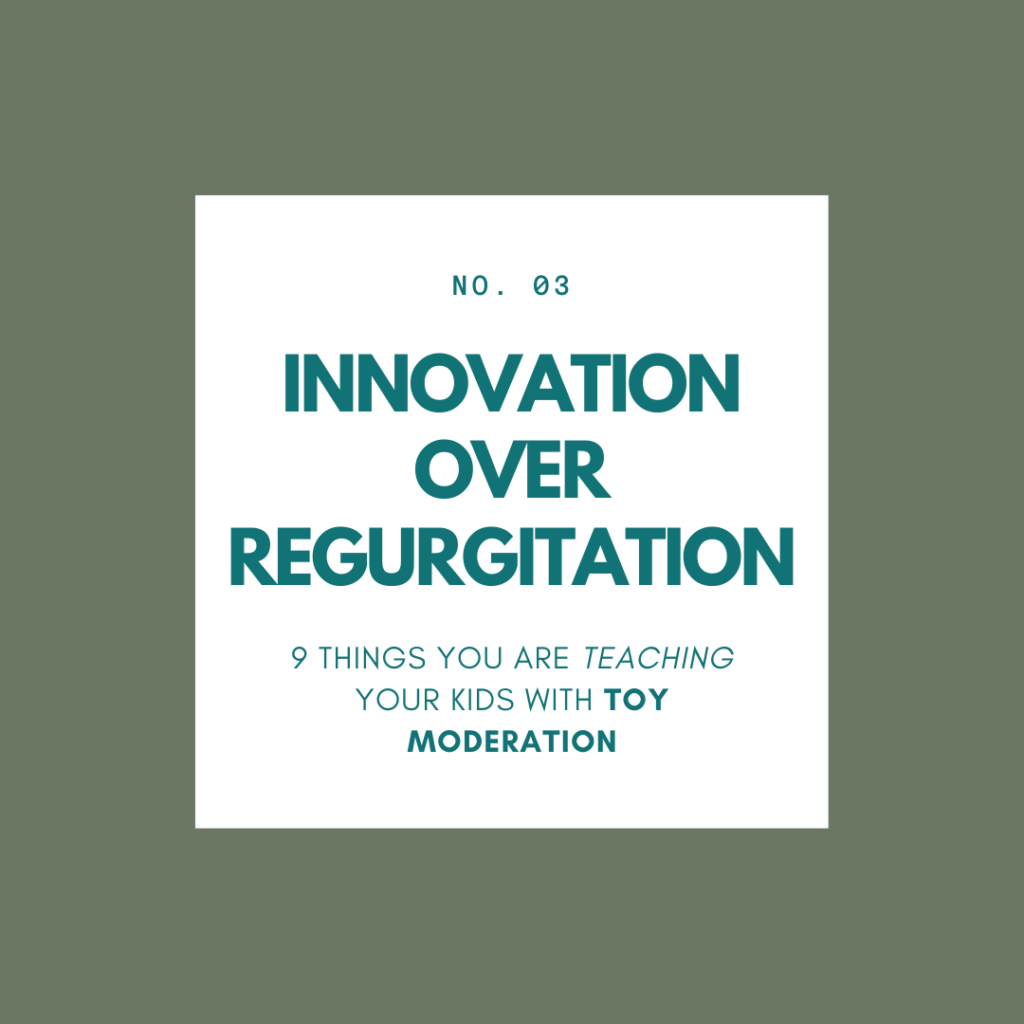
3. Innovation Over Regurgitation
When we give our kids a lot of toys we may be taking away their opportunities to innovate. How do you “make something from nothing” when you have everything? When we moderate the quantity and quality of toys in our homes, we are inviting creativity and resourcefulness.
This story from Kathryn, a recent Foundations participant says everything:
“My son loves Moana, I mean loves it! Last year when we had our last play date (at least it feels like a year haha) he was playing with his friends plastic Maui fish hook. I remember thinking to myself I should get him one, he’d love it but then forgot. Fast forward to this week, he has been really into Moana again. We played pretend today. I was Moana, he was Maui, a wooden spoon was his fishhook, a wooden vegetable was Hei Hei, a rock was the heart, and a wooden cutting board was my oar. He came up with all of this, at 3 years old and I’m just so impressed. His imagination amazes me and I truly believe I owe it all to not having as many toys. I’m so glad I took Foundations and have learned so much! Denaye’s recent post about plastic reminded me that I chose not to give in to the plastic and I’m so glad I did!”
Having fewer toys does not hinder our children’s development, it enhances it. When you consider the benefits of fewer toys for kids, we know that cognitive skills like executive functioning, creativity, and problem-solving are enhanced through a simpler life with fewer toys, obligations, and more opportunities for self-direction.
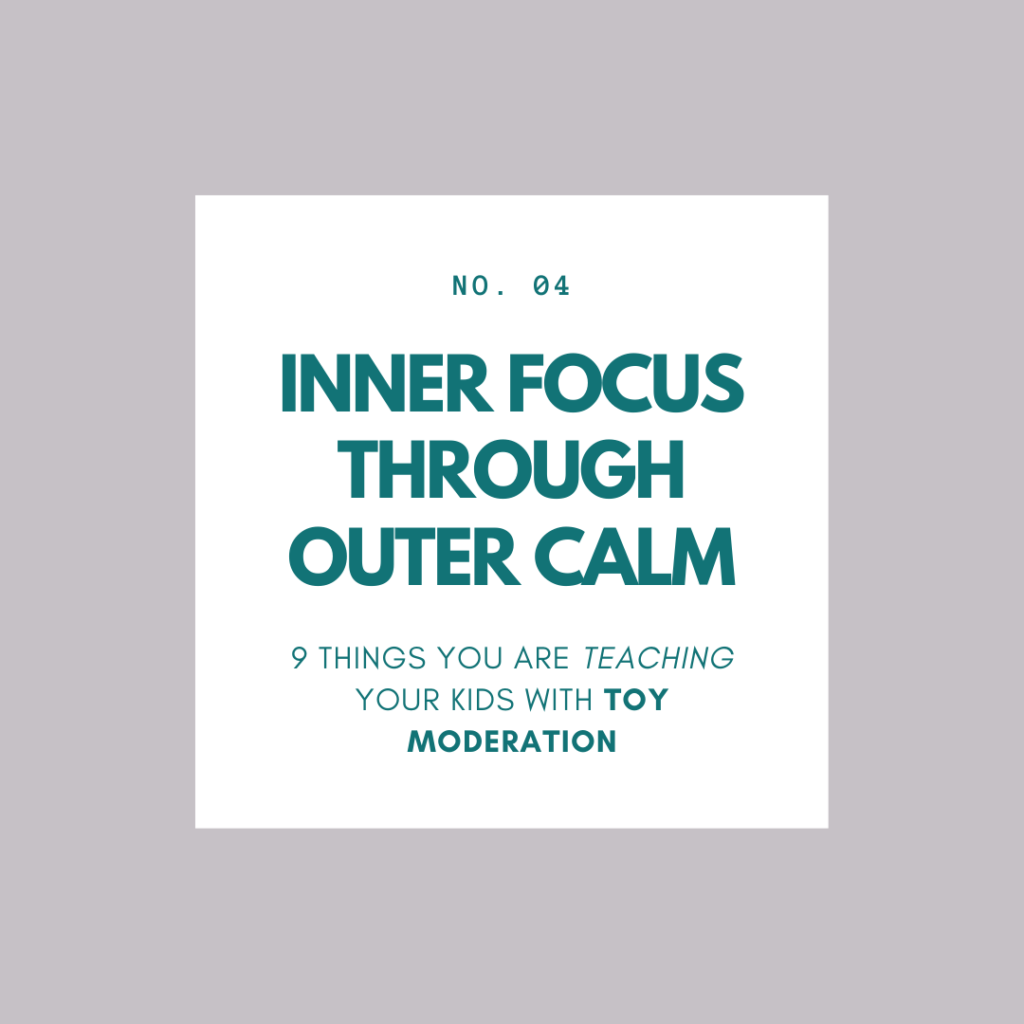
4. Inner Focus Through Outer Calm
How does it feel to be in a freshly cleaned and decluttered room? It feels good. It feels like a place in which you’d like to spend a serious amount of time.
How does it feel to be in a toy room that is ‘trashed’ with all the bins dumped and stuff lying everywhere? It doesn’t feel good. It feels like a place you’d like to shut the door on and never return. [Hint: our kids feel like this about packed play spaces too!]
Cluttered spaces make it hard to think and focus. Not only can I tell you this from personal experience, but the research shows us this as well. We know kids focus and learn better in less cluttered rooms. We know that they play more creatively when they have fewer toys. And we know that humans have lower stress levels when they are in tidier spaces.
Although we can often get caught up in gifting our kids the best, most fun toys…what if the greatest gift of all was LESS toys and more white space to think, create, and grow?
WANT THE LIST OF THE 15 BEST SIMPLE TOYS?

5. Humans Thrive in Nature
The hard truth is that humans were not originally intended to grow and live in climate-controlled, air-tight homes. We were meant to feel the cool breeze on our faces. We were meant to feel the rain. To sweat. To shiver. To feel pangs of hunger.
We were meant to get uncomfortable. If I had a dollar for every time someone told me that their kid “isn’t into nature”–I’d be retired. The reality is that nature is uncomfortable. Bugs. Heat. Wind. Snow. You get it, right? So perhaps we have a kid who “isn’t into getting uncomfortable”. But don’t blame nature.
Humans thrive in nature. Our bodies and brains need the sensory input and movement that come from being outside.
Do you have to hike in a National Park to enjoy nature? No. Do you have to live near a waterfall to enjoy nature? No. Just exit the building you are in (assuming you are not in quarantine!) and go outside.
So how does this relate to the benefits of fewer toys? We spend a great deal of time and money arranging the “perfect” indoor play spaces within our homes. But the truth is—they are better off outside than in your perfectly curated toy room. When you moderate the quantity of toys in your home, you are teaching your children that the most important growing and playing doesn’t even happen there. It happens in the great outdoors.
[P.S. I know some people cannot go outside due to the pandemic right now. It sucks, I know! Here in New York our parks and preserves were closed for a long time. Can you get creative in ways to get out?]
[P.P.S. If you have a child with a sensory disorder—outdoor time may look different for them! But it’s still essential]
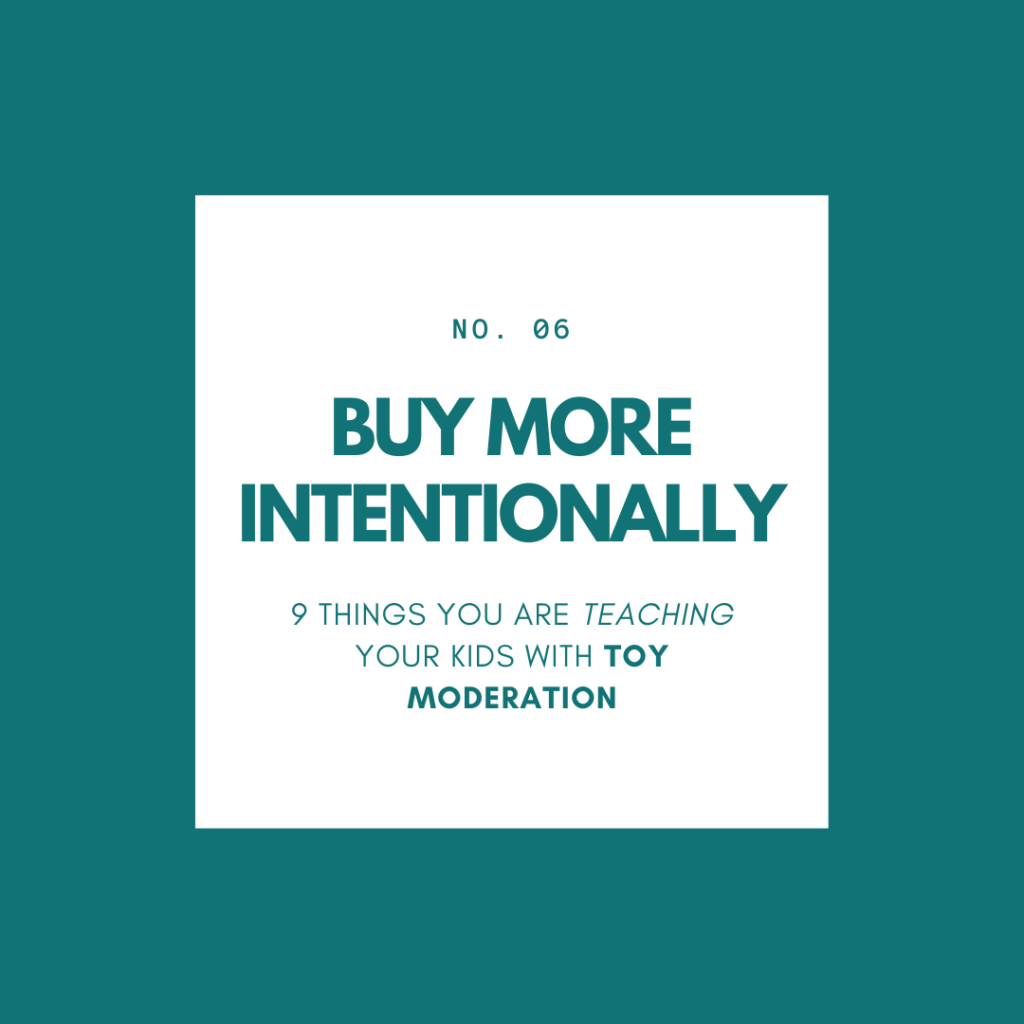
6. Buy More Intentionally
I remember shopping for school clothes as a young child. We would pick out the clothes we needed and then put them on layaway at the local department store. The store would keep the clothes until we had all the money to pay for them. So we would pay for them little by little over the course of a few weeks and then when they were paid off, we brought them home. I was so excited about those clothes and waiting wasn’t easy.
How foreign this feels now.
In our present reality, credit cards allow us to live far beyond our means. That means there is no “waiting until you pay it off”. We live in a world of immediate gratification. Impulse buying is synonymous with regular buying. Making a trip to Target and throwing in half the housewares/art department and a few Paw Patrol vehicles is nearly the status quo.
When we say “no” and moderate the quantity of toys our children bring home we are modeling thoughtful and intentional buying, which is just one more benefit of fewer toys. We are teaching them to consume more consciously, not only for the sake of the environment, but also for the sake of their future wallets.
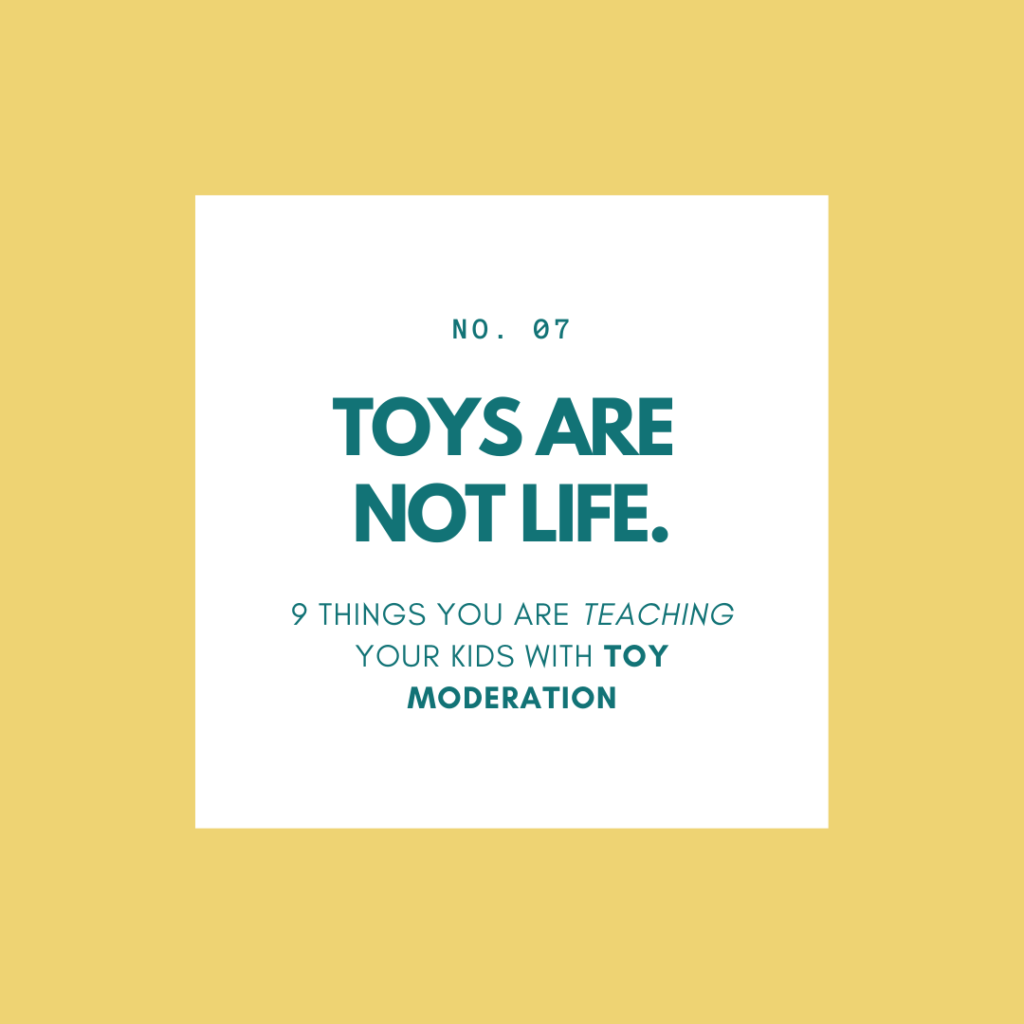
7. Toys Are Not Life
Kids learn through play. That makes toys their most obvious “tools” for learning. But the tools for play are by no means limited to toys.
I need you to weigh in on this one—who else sees this? My kids spend most of their time doing anything but playing with toys. They cook, climb, stack pillows, create with paper, play outside, sing, run, dance, jump…but day in and day out their lives do not revolve around toys.
So no, they don’t really need that many toys. There are plenty of other delightful things for kids to do in this world that don’t involve toys at all. They are dynamic, curious human beings with varied interests that will lead them to explore and create with materials and places that are far more interesting than anything a toy company can think up.
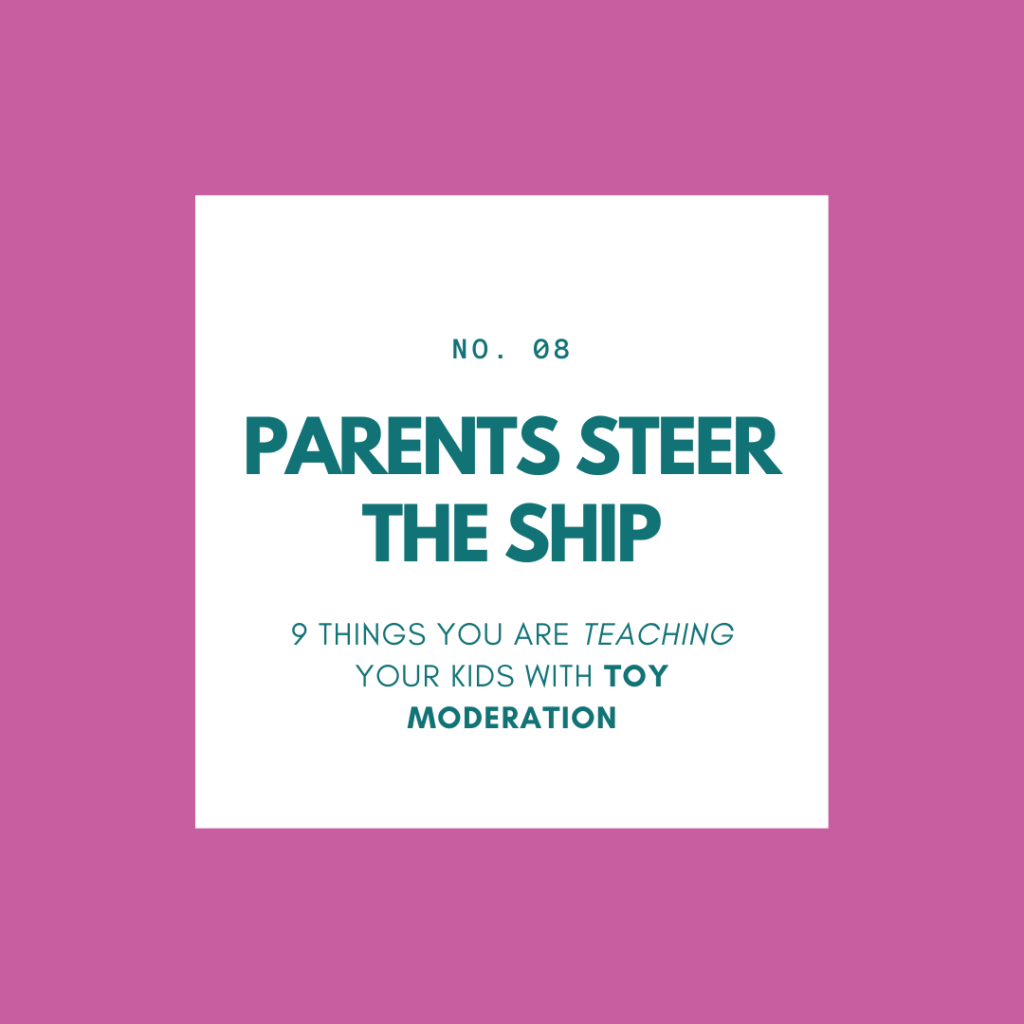
8. Parents Steer the Ship
As parents, we have to steer the ship. As believers in the benefits of fewer toys, we have to be the guides. But this can get confusing—we want to empower our children and give them choices…but we also need to tell them what to do? How do we find a balance?
Let your children choose their snack. Let them choose their shirt. Let them choose their friends. But make choices for them when those choices have an impact on their overall well-being.
Here’s why. Parents have fully developed brains and decision-making skills. We can weigh pros and cons. Parents can fully understand the negative implications of too many toys. We know that cognitive skills like executive functioning, creativity, and problem-solving are enhanced through a simpler life with fewer toys, obligations, and clutter.
We have to make hard decisions for our families. And sometimes that means decluttering the toys. We can absolutely bring our kids into the process but at the end of the day, we are steering the ship. We are navigating towards the betterment and well-being of our whole family—because our kids aren’t completely able to do this for themselves yet.
When we can, involve kids in the decluttering of the toys. We have to be respectful, but we can’t let their reservations prevent it from happening altogether.
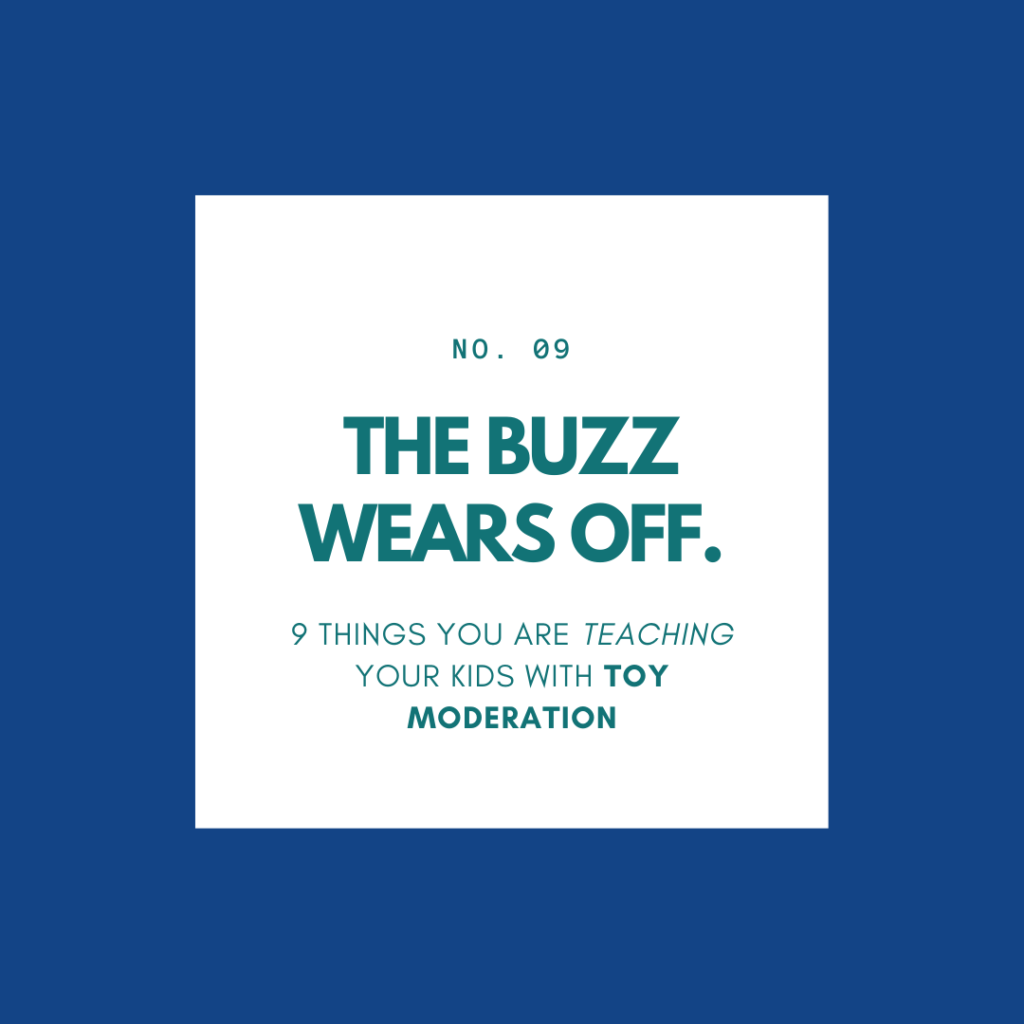
9. The Buzz Wears Off
You all know the feeling. The delivery truck has just dropped an unexpected package at your front door. Your dopamine receptors light up in anticipation—WHAT COULD IT BE? You can’t wait to open it.
Then you find out it’s just your bimonthly shipment of multivitamins. SIGH.
The anticipation of new + novel things is human nature and it happens to all of us. It’s normal and it’s exciting. Even as adults, we find the buzz that hits us to be irresistable. But the buzz is fleeting. With children, it’s very easy to mistake the ‘new stuff buzz’ with happiness. Let me assure you that the ‘new stuff buzz’ will not bring lasting happiness.
By moderating the quantity and quality of toys coming into our home, we are teaching them that we need to be thoughtful about the stuff that comes into our home. Because when the ‘new stuff buzz’ wears off we are going to need to figure out what to do with all this junk.
Don’t buy toys for the ’new stuff buzz’. Buy toys when they will bring added lasting value + joy to the lives of your children.
The benefits of fewer toys will continue to delight you in more ways than you can image–just give it a try!
WANT THE LIST OF THE 15 BEST SIMPLE TOYS?
Hi there. This is episode 228. And today we're talking about moderating the toys. That means being more intentional about the quality and the quantity of toys coming into your home. To me, moderation evokes this idea that we can be intentional and we can be moderate without being too restrictive without going too overboard. And I think in there in that moderation, we can find a balance that really makes everybody happy. The kids, the parents, the whole family, and today we're diving into why it's important to be more intentional with the toys. Sure. Maybe they're driving you crazy and you're tripping over them left and right. But the truth is having less is better for your kids and it's better for you. So in today's episode, I'm going to tell you more about how your kids are going to grow and thrive through having less.
Hi, this is Denaye. I'm the founder of Simple Families. Simple Families is an online community for parents who are seeking a simpler more intentional life. In this show, we focus on minimalism with kids, positive parenting, family wellness, and decreasing the mental load. My perspectives are based in my firsthand experience, raising kids, but also rooted in my PhD in child development. So you're going to hear conversations that are based in research, but more importantly, real life. Thanks for joining us.
Hi there. And thanks for tuning in today. We are talking about toy moderation. That means being more intentional about the things that we bring into our home and the benefits for our children. Now, if the toys are feeling overwhelming for you and you don't no where to get started, you're looking for a helping hand. I am doing a live workshop on simplifying the toys on Thursday, go to simplefamilies.com/toys, and you can get all the information there.
And if you can't log in live, you can always register and view the replay later. Again, that's simplefamilies.com/toys. Now this week's episode was inspired by a quote that I read by Rob Bell. Here's what he said. You are always teaching your kids. And sometimes you even use words. I'll read that again. You are always teaching your kids and sometimes you even use words. I really loved this quote because it reminded me of the fact that often we think that we're teaching our kids. When we sit them down and we have a lecture, we're giving them some sort of directive, formal education, but the truth is just like Rob says, we're teaching our kids all the time. We're teaching them through modeling. We're teaching them through our actions. They're always watching for better or worse. Now I think one of the biggest mistakes that we can make is putting too much pressure on ourselves to be someone that we're not.
And I always fear when I say this, this idea that, you know, your kids are always watching you. They're always learning from you that it starts to feel like a lot of pressure. I know for me personally, I strive to do my best, but I also know that I'm going to make mistakes. I'm going to trip up. I'm not going to be perfect. And I don't even strive to be perfect. I don't strive to know everything. I don't strive to get it all right all the time. And it's really important that we offer ourselves a lot of forgiveness and a lot of grace because we're showing our kids that it's okay to make mistakes. Now, if you're anything like me, you haven't always bought intentionally. You've done a lot of impulse purchasing in your lifetime. I'm definitely guilty of that. Impulse buying has become sort of the status quo.
And when it comes to our kids, we're more susceptible to impulse buying than ever before, because who doesn't like to buy something new for their kids and see them light up. So I've been talking for years about simplifying the toys. I've helped thousands of families do it. It's something I am so passionate about. The research shows us that simplifying the toys supports the development of children, but it also supports the well-being and emotional health of parents too. So as we're moving to find a better balance with our kids and the toys, we have to remind ourselves that the way that we buy for our children teaches them. Is it okay to surprise them with a random piece of dare I say, junk or shrink it from, from time to time? Yes, absolutely. But let's not make it the norm. Let's not make it daily because they're watching.
So I came up with a list to give you a little bit of inspiration to stay on course and simplify the toys with your kids. Now, this list is nine things that you are teaching your kids with toy moderation. So I wanted to start out the first one with a little bit of environmentalism.
So number one is just say no to crap. Now use the word crap, because it's really the only word that suffices here. There's a lot of toys out there that are just crap. I'm sorry if your kids are listening and that's a bad word in your house. Now we often feel mean about saying no to crap. Maybe it's a McDonald's happy meal toy, right? Have you ever been the mean mom in line at McDonald's saying no, your kid can't have a toy. I have. The first time is really hard, but it gets easier.
It gets easier on everybody. And when we tell our children no to new toys and we limit the number of trinkets that they acquire, we're not being mean. We are teaching. We are teaching our children that what comes into our house eventually has to leave. We are not going to be buried with those happy meal toys. And I think what most people don't realize is that plastic toys have to go somewhere. They don't die with us. They don't die. When we put them in the garbage can. Most of that plastic stuff ends up in the landfill and plastic toys are notoriously hard to recycle. They can live in the landfill for up to 500 years. So if you have a kid that is dying for the Barbie dream house or the giant plastics, then reindeer that I spotted at target last year on the holidays, just tell yourself that, that Barbie dream house and that three and a half foot tall Sven reindeer are going to outlive your grandchildren's great, great grandchildren.
So as parents with fully developed brains and reasoning skills, it's our job to say no to the crap, the crap I'm going to go straight to the landfill. After our kid loses interest in it, we have to say no to the flashy stuff that the marketers dump billions into selling our kids. We have to be more thoughtful and intentional about the way that we're buying toys for our kids. Because when we say no to junk, we're sending our kids a message the way that we buy matters. And we have an impact on the world that is greater than we know individual people and individual families play a role in the overall health and wellness of our planet.
Number two, stand up for what matters. So I know what you're thinking. You don't even buy all these toys. It's the grandparents, the grandparents always get the blame, whether they deserve it or not. I'm not going there today, but I hear this all the time. And I know that it is super awkward to have this conversation with your family members about buying less for your kids. It's awkward because you don't want to feel ungrateful. You don't want to feel unappreciative and you get it. Like you understand how fun it is to buy stuff for kids, seeing their faces light up as a parent. I think you do firsthand understand how good it feels to see your kids light up with joy. But if you are trying to be moderate with your toys and there's other gift givers in the family who are moving down a different path, you have to have a conversation. Actually. You're probably going to have to have more than one conversation. There's a lot of people out there who take the approach to just smile and say, thank you.
And then they donate everything later. But to me, that never felt right. I always felt like there was guilt sticking around and that someone was going to notice and someone was going to find me out. But I'm here to tell you that you have to be brave. You have to talk to the family members and it's going to be more than once. You have to be tactful and you have to be polite and kind and understanding. But at the core, you need to communicate that simplicity is a core family value that you're trying to teach your kids and that you need their help. And if that's true, if simplicity is a core family value that you're trying to instill in your children, then it's really important that you stand up for that family value, because there's going to be a day probably too far in the future that your children are going to be tested and they are going to need to stand up for the family values too.
And as a parent, it's your job to show them how to do it and to show them how to be brave, even when it's uncomfortable. So I pulled this quote from my book, simple hobby parenting. It's an example of a way to start the conversation. You can try this one. Our kids love spending time with you, and I've enjoyed seeing your relationship grow, but I worry that too many packages may distract them from appreciating all the wonderful things that you bring as a person. I want them to look forward to the special time with you more than they do the gifts. How can we work together to keep them focused on the important stuff? So remember after you have this conversation, be patient expect that there might be a little defensiveness. This is not going to be an overnight change. You're probably going to need to repeat some of it in some form. At some point, it's going to take time and repetition, but it's worth it. And the people you love will come to understand, and we'll come to respect it with time.
Number three is innovation over regurgitation. When we give our kids a lot of toys, we might be taking away their opportunities to innovate. How do you make something from nothing when you already have everything? When we moderate the quantity and the quality of toys in our home, we're actually inviting creativity and resourcefulness. And the research shows this. So take this into consideration when you're bringing new toys into your home. Is this a toy that can be used in many ways, by many children of different genders and different interests and different ages? Or is it something that has a very specific prescribed way to play?
Is it inviting innovation or regurgitation? I love this story from Katherine who has a recent participant and my simple family's foundations program. Here's what she had to say. My son loves marijuana. I mean, he loves it last year when we had our last play date, at least it feels like a year ago. He was playing with his friend's plastic Maui fish hook. I remember thinking to myself that I should get him one he'd love it, but then I forgot fast forward to this week. He's been really into Moana. Again, we played today. I was Moana and he was Maui. A wooden spoon was his fish hook. And it wouldn't vegetable was, Hey, Hey, a rock was the heart of Te fiti. And the wooden cutting board was my ore he came up with all of this at three years old. And I'm just so impressed. His imagination amazes me.
And I truly believe that I owe it all to not having as many toys. I'm so glad I took foundations and I've learned so much. The story is just one of many, because the truth is that having fewer toys does not hinder our children's development. It enhances it. Now, when I was a new mom, a few years ago, I wanted to get every educational, beautiful wooden toy that was on the market. I could always make an excuse that a toy was good for my kids in some way, shape or form. But as I learned, and as I grew, I started to understand what we know to be true. By having less toys, our kids have more opportunity to exercise their executive functioning skills. They have more opportunities for creativity and problem solving. These things are enhanced with a simpler life, with fewer toys and fewer obligations.
Number four, inner focus through outer calm. Do you know how it feels to be in a freshly clean decluttered room? To me, it feels really good. Like a place that I want to spend a lot of time. Like when you walk into a hotel room, it's perfectly clean. There's not a lot of stuff. Just the necessities. Now flip that. How does it feel to be in a room that is trashed for lack of better words, have your kids ever trashed their play space turned all the bins upside down through all this stuff on the floor. Everything lying everywhere. It doesn't feel good. It doesn't feel like a place you want to spend time. It feels like a place you want to shut the door and forget about now. You aren't the only one that feels like this. Your kids feel like this too. So if you have a packed play space and your kids never seem to want to be in there, this might be the reason why cluttered spaces may get hard to think and focus for adults.
And for kids, not only can I tell you this from personal experience, but we know that kids focus and learn better in less cluttered rooms and they play more creatively when they have fewer toys and humans as a whole have lower stress levels in tidy or spaces. So I know we can get caught up and gifting our kids the best and the most fun toys, the most educational toys, but consider this. What if the greatest gift of all was less toys and more white space to think and create and grow.
Number five is humans thrive in nature. The hard truth is that humans were not actually intended to live in climate controlled airtight homes. We were meant to feel the elements, the cool breeze on our faces, the rain, the sweat, and to feel pangs of hunger. We were meant to get uncomfortable. Now, If I had a dollar for every time that someone told me that their kid isn't into nature, I'd probably be retired because the reality is that nature is just really uncomfortable bugs and heat and wind and snow.
If you're not into nature, then you definitely get this right. Even if you are into nature, you probably still can have some appreciation for the fact that it gets uncomfortable, but ask yourself, maybe it isn't that you have a kid that's not into nature. Or maybe you have a kid that's not into getting uncomfortable. Maybe you are not into getting uncomfortable, but don't go straight and blame nature. Humans thrive in nature. We know that our bodies and brains need the sensory input and the movement that come from being outside. And you don't have to go to a national park to enjoy nature. You don't have to go to a waterfall.
You can just walk outside. Even if you live in the city, breathing the air, feeling the wind, experiencing it. So you might be wondering now, how does nature relate to toy moderation? So we can spend a lot of time and money arranging the perfect indoor spaces in our homes, especially when it comes to play. But the truth is that our kids are better off outside than in that perfectly curated toy room. So when you moderate the quantity of toys in your home, you're teaching your children that the most important growing in playing doesn't even happen there. It actually happens outside in the great outdoors. Now I know that a lot of people don't have the same opportunities to get outside due to the pandemic right now. And I know, I know this is hard. We live in New York and our parks and preserves were closed for a long time.
But try to think outside the box, can you get creative in the ways to get out? We spent our first several summers as parents in Texas, where it was hot. That meant if we wanted to get out, we had to do it early and often we were out the door by 7:00 AM on Saturday and Sunday mornings. And we were still sweating getting outside. Isn't always easy, but it's always worth it. And if you have a kid with a sensory disorder, outdoor time might look a little bit different, but it is still essential.
Number six by more intentionally, I remember shopping for school clothes. When I was a kid, I would go with my mom and we would pick out the clothes that we needed. And then we put them on layaway at the local department store layaway. If you're not familiar with it was where you left the clothes at the store and they put them in the back until you had all of the money you needed to pay for them.
So we would go back and we would make payments on the clothes little by little until they were paid off. And then we would bring them home. And it wasn't easy to wait on these clothes because I was so excited for them. But reflecting back on this, it feels so foreign to me now because in our present day, reality credit cards allow us to live far beyond our means. That means there is no waiting until you pay it off. We live in this world of immediate gratification.
Impulse buying is synonymous with regular buying. So making a trip to target and in half the housewares and art department and a few pop patrol vehicles, that's nearly the status quo. But when we say no, and we moderate the quantity of toys that our kids bring home, we're modeling thoughtful and intentional buying, and we're teaching them to consume more consciously, not only for the sake of the environment like we talked about before, but also for the sake of their future wallets.
Number seven, toys are not life without even realizing it through our actions. We might be teaching our kids that toys are life. That they're one of the most important things that the seeking and the receiving trumps all we know that kids learn through play, which makes toys are most obvious tools for learning. But the tools for play are by no means limited to toys. Now, I know a lot of you out there listening are going to be nodding your head in agreement with me on this, but my kids spend most of their time doing anything, but playing with toys, they cook and they climb and they stack pillows and they create stuff with paper. They play outside and sing and dance and jump. But day in and day out their lives do not revolve around toys.
So no, you don't really need that many toys. There are plenty of other delightful things for kids to do in this world that don't involve toys at all. Our kids are dynamic and curious human beings with varied interests that are going to lead them to explore and create with materials and places that are far more interesting than anything. A toy company can dream up.
Number eight is parents steer the ship. For some reason, I really love this analogy. I just have this visual of a parent standing in the front of a ship with their hands on the wheel. And it's true. That's where we need to be. We have to be the guides. We have to be the navigators. Remember we're the ones with the fully developed brains and the fully developed decision-making skills. But it's confusing because every parent book you read says that we need to give kids choices. So we need to give them the choices we need to empower them and let them make decisions for themselves.
But we also need to tell them what to do. So how do we find a balance? We can let children choose many things in their life. As many things as possible. We can let them choose their own snack, their shirt, their friends, but when the choices that they make have an impact on their overall wellbeing. That's when we have to take the wheel as parents, we can weigh the pros and cons. We can fully understand the implications of things like having too many toys. And sometimes we do have to make hard decisions for our families. And maybe that means decluttering the toys in your house. We can absolutely bring our kids into the process, but at the end of the day, we're there resteering the ship we're navigating towards the betterment and wellbeing of our whole family, because our kids aren't completely able to do this for themselves yet.
So if you have a kid that's hesitant understand that we have to be respectful and we have to involve kids when possible in the process of decluttering the toys. But we also have to move forward. We also have to navigate we're pointed in the direction of a calmer home that focuses on connection over content. So keep moving forward.
And lastly, number nine, the buzz wears off. You all know the feeling, right? The delivery truck drop this unexpected package at your front door. We have a little bench in front of our house that the delivery men drop the packages. And, and for me, and probably for most of you listening, your dopamine receptors, they light right up. There's so much anticipation. What could it be? You can't wait to open it. And then you find out that it's just your bi-monthly shipment of multivitamins.
This anticipation of new and novel things is part of human nature. And it happens to all of us. It's normal. And it's exciting. Even as adults, we find this buzz to be irresistible, but we have to remember that that buzz is fleeting. And with children, it's very easy to mistake the new stuff, buzz with happiness. And I want to assure you that the new stuff buzz that you get when you rip open a package does not equate to long lasting happiness by moderating the quantity and the quality of toys coming into our home. We're teaching our kids that they need to be thoughtful about their own consumption. Because when that new stuff buzz wears off, we're going to have to figure out what to do with this stuff. So exercise caution, try to avoid buying new toys, just to see your kids light up because that stuff is going to last in your house.
And it's going to last in the landfill a lot longer than that fleeting joy that it brought to your child. So buy toys when they're going to bring added lasting value and joy to the lives of your children. I hope this has been helpful. If you want to visit any of the things that I talked about, or if you just want to reference some of these, you can find the show notes at simplefamilies.com/episode228. And if you're feeling inspired and you want to move forward and you need a helping hand, I'd love to have you join us in the workshop on Thursday, we're focused on decluttering. The toys got a simple families.com forward slash toys. If you have enjoyed this episode and you've learned something from it, screenshot yourself, listening to it and post it up in your Instagram stories, make sure that you tag me so that I can reshare it as always. Thanks for tuning in, and I'll chat with you next week. Next week, we're going to be talking about back to school decisions. There's a lot to unpack there. I look forward to chatting with you, then have a good one.
